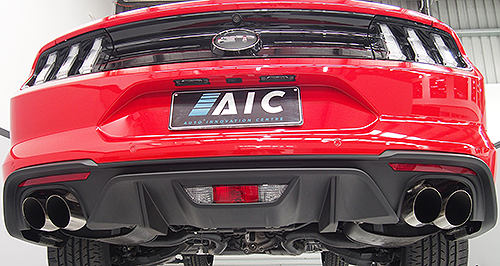Make / Model Search
News - Industry NewsAIC to meet strong demand for testingKnowledge bank: Luke Truskinger with a Ford Mustang on the hoist at the Melbourne AIC, a vehicle that is an obvious target for modification by the local aftermarket sector. New Auto Innovation Centres to build data library that aftermarket can draw on16 Dec 2019 By IAN PORTER THE newly opened Auto Innovation Centre (AIC) in Melbourne has been created to help the country’s remaining automotive parts-makers develop new parts and accessories in a hi-tech environment that will shorten the industry’s time to market.
Speaking to GoAuto at the opening of the centre last week, which will be followed by a second facility in South Australia next year, AIC managing director Luke Truskinger said a key part of the operation will be the accumulation of a library of data obtained from the vehicles most likelyto be modified by Australian vehicle owners, principally sportscars and off-roaders.
Typical vehicles seen in the workshop at the opening included the Ford Mustang and Toyota Supra.
“When it comes to any of the cars you see here, these are target vehicles, something that is likely to be modified. This Mustang, for instance, all the four-wheel drives,” Mr Truskinger said.
“We will basically document everything we can about that vehicle and make a library of data. The weight of it, the height, the length, everything you need to know to make an accessory.
”This will help ensure that parts fit first time and do not interfere with safety systems already built into the vehicle.
“For a bullbar, say, we’ll scan the front of the vehicle and provide ADAS (advanced driver assistance systems) calibration facilities, so you can put your bullbar onand find whether the radar and camera need to be recalibrated. All those things.”
Testing of modified suspensions to ensure the electronic stability systems still work as planned will be a significant service.
The Melbourne AIC had four ESC test programs booked even before it opened its doors.
In addition to such specific parts projects, the AIC will also offer a range of “pay per use” services so it can become a hub for the parts industry.
These include use of the facility, renting a vehicle and testing services like ESC brake testing and hydraulic vibration.
The centre can also do 3D printing and offers training room hire and conferencing facilities.
“Anyone who has an idea to put an accessory on a Mustang or a 4WD or whatever can come here and say, ‘Can you help me?’ They don’t even have to be members of the Australian Automotive Aftermarket Association,” Mr Truskinger said.
“We are wholly owned by the AAAA, but we are our own business so we’ll have our ownsubscription model and our own pay-per-use model.”
A key part of the strategy behind the creation of the AIC is to help streamline the different regulations in various states that make it difficult for parts-makers to have the products approved in every state in an acceptable time frame.
“We can’t fix (fragmented regulation) overnight. But they’re definitely working together. Having a place like this that ties the industry together helps tie (the regulators) together as well. They obviously have a desire to have a common approach, as evidenced by the fact they have come here to have a chat today,” Mr Truskinger said.
“We are very closely tied into them so we can provide clarity and make sure we can help bring state and federal regulators together, as well as the industry, to get a common-sense approach to approving vehicle products.”
Mr Truskingersaid the AIC was also open to international parts-makers, meaning there were hundreds of potential customers.
“The AAAA has its Automotive Products Manufacturers and Exporters Council, which has a couple of hundred members,” he said.
“There are a lot of people developing products. Also, we have people from international markets here as well. They want to develop products for the Australian market. It’s important for us to help make sure that the products coming in are compliant.”
He said different laws and regulations in other countries mean that a part that fits a particular model in one market may not be suitable in Australia.
“Vehicles are different. A LandCruiser in Malaysia, say, is different to a LandCruiser here,” said Mr Truskinger, adding that without the support of the AIC’s five sponsor companies, the centre would not have become a centre of excellence in product development.
“Bosch helps out with the calibration of ADAS to make sure radar and cameras are not affected by new parts, Burson helped with precision workshop equipment, Continental provides a wealth of tyre data to assist in suspension simulations, Hella Gutman also helps with ADAS calibrations and Repco provides hand tools and a lot of other equipment.
“Without this support we wouldn’t be able to showcase this centre of excellence and show what Australian industry can do and why this is a centre of best practice.”  Read more16th of December 2019  Parts sector aims to iron out state roadblocksNew AIC could eliminate cross-border regulatory hassles for accessory manufacturers16th of December 2019  First Auto Innovation Centre up and runningVictorian AIC open, SA to follow, in bid to maintain viability of local parts sector |
Click to shareIndustry News articlesMotor industry news |











Facebook Twitter Instagram